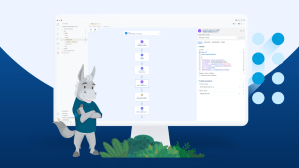Excitement among Australian desk workers surrounding the use of AI at work is growing. According to the latest figures from Slack’s Workforce Lab, AI usage Down Under has climbed to 37% – the highest of all countries surveyed – and is up 6% since the beginning of the year, and 35% since September 2023.
And while roughly half of Australian desk workers (49%) have expressed enthusiasm for incorporating AI into their daily tasks, the survey also revealed some areas of concern for local businesses.
Why it matters: According to a 2023 Gallup report, nearly half (47%) of Australian workers experience stress during most of their workday – the second-highest rate in the world. With the advent of AI, many workers thought the days of busy work were finally over. But because of persistent training and trust issues, today’s employees still aren’t unlocking AI’s benefits.
The new survey shows that Australian workers plan to focus their free time on the very tasks they should be delegating to AI while pushing high-value focus areas like innovation, creativity, and professional development down the list. The bright side is that those trained to use AI are up to three times more likely to report that it’s improving their productivity.
“We’re at a crucial turning point with AI. If we want to make the most of what AI can offer without just ramping up stress and burnout, it’s on us as leaders to equip our teams with tools they can trust and help employees steer that extra time into the most rewarding and impactful work,” said Christina Janzer, Head of Slack Workforce Labs
The Slack survey found:
Desk workers suffer from busywork-driven burnout: Australian employees are feeling the grind and report spending large chunks of their day on mundane tasks.
- Most desk workers (71%) experience burnout once a month or more.
- 29% of workers don’t feel a passion for their job.
- Over a third of the workday is spent on tasks that are “not meaningful to their job,” such as unnecessary meetings, low-value emails, and excessive paperwork or data entry.
- entry.
Trust and knowledge gaps hold workers back from fully leveraging AI: Australian desk workers are excited about AI but don’t yet trust it to take over tasks during the workday.
- Only 5% completely trust AI to handle work tasks, lower than the global average (7%).
- Only 13% of desk workers strongly agree that they have the education and training necessary to use AI effectively.
Businesses must empower their workforce to use AI effectively: For workers to trust and delegate tasks to AI, companies must train their workforce on how to get the most out of it.
- In Australia, desk workers at companies that have established permissions for AI use are nearly five times more likely to have experimented with AI tools.
- Workers who are trained to use AI are three times more likely to report that AI is improving their productivity.
What should leaders do to encourage more uptake? The PET plan: permission, education, training
Step one to boost workplace AI use is to clarify permission by establishing clear usage guidelines. This may sound obvious, yet nearly two out of five desk workers globally (37%) say their company has no AI policy.
The next step is education and training. Only a very small portion of global desk workers (15% globally, and only 13% in Australia) strongly agree that they have the education and training necessary to use AI effectively. Unsurprisingly, the more training and education workers have, the more likely they are to use AI tools, and those who are trained to use AI are up to 19 times more likely to report that AI is improving their productivity.
Notably, education and training are fundamental components to building trust in AI tools. Desk workers who are well-trained in AI are seven times more likely to trust AI tools to assist them with work-related tasks compared to desk workers lacking AI training.
“Australia has the highest adoption rate amongst its global counterparts, yet it has among the lowest level of trust in AI-generated outputs. In order to achieve the potential benefits in AI, we suggest leaders invest in AI training to achieve better productivity and trust in these tools,” added Janzer.
With the proper training and support, Australian businesses can unlock a smarter, simpler and more satisfying way of working
Christina Janzer, Head of Slack Workforce Labs
More information:
- Despite AI enthusiasm, the global Workforce Index reveals workers aren’t yet unlocking its benefits
- Find more global stats and data on worker AI adoption in the Salesforce stat library
- Find AI training resources on Trailhead
The survey included 10,045 workers in the United States, Australia, France, Germany, Japan, and the U.K., and was fielded between March 6 and March 22, 2024. In total, 992 workers were surveyed in Australia.
The survey was administered by Qualtrics and did not target Slack or Salesforce employees or customers. Respondents were all desk workers, defined as employed full-time (30 or more hours per week) and either having one of the roles listed below or saying they “work with data, analyze information or think creatively”: executive management (e.g. president/partner, CEO, CFO, C-suite), senior management (e.g. executive VP, senior VP), middle management (e.g. department/group manager, VP), junior management (e.g. manager, team leader), senior staff (i.e. non-management), skilled office worker (e.g. analyst, graphic designer).
For brevity, the article refers to the survey population as “desk-based” or “desk workers.”
















